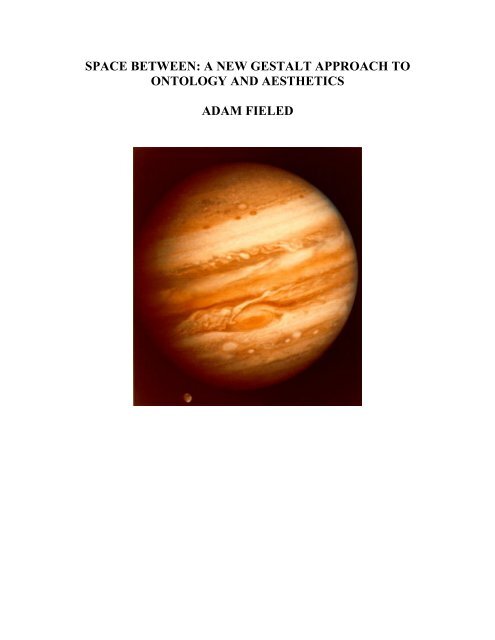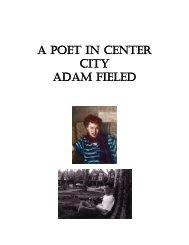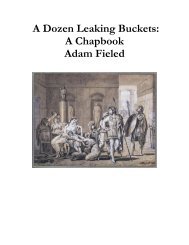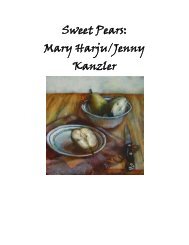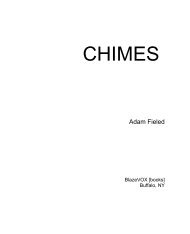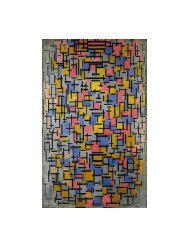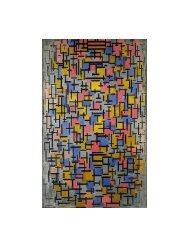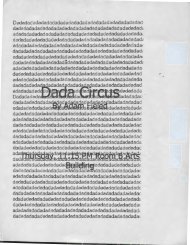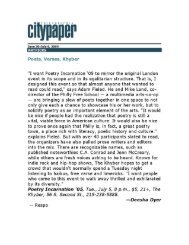SPACE BETWEEN: A NEW GESTALT APPROACH TO ONTOLOGY AND AESTHETICS
A collection comprised of new discursive material around ontology and aesthetic by Adam Fieled.
A collection comprised of new discursive material around ontology and aesthetic by Adam Fieled.
Create successful ePaper yourself
Turn your PDF publications into a flip-book with our unique Google optimized e-Paper software.
<strong>SPACE</strong> <strong>BETWEEN</strong>: A <strong>NEW</strong> <strong>GESTALT</strong> <strong>APPROACH</strong> <strong>TO</strong><br />
ON<strong>TO</strong>LOGY <strong>AND</strong> <strong>AESTHETICS</strong><br />
ADAM FIELED
Apologia<br />
I have taken the liberty, in this collection, to introduce this sentence into a<br />
presupposed matrix of philosophical discourses: “There is space between time, space<br />
between space, and space between causes.” Whether or not it is boldly presumptuous to<br />
do so is an open question. The necessity for “Space Between,” as a linguistic sign<br />
representing an ontological “incision,” was born from an acknowledgment, “past”<br />
Heidegger, that Dasein (Being-In) could engender an “adjunct” of commensurate power,<br />
which could extend it indefinitely into a new century and its projected discourses. Space<br />
Between is not “over” Deconstructionism and the deconstructionist discourse, but<br />
subsists on either side of it— affirming its status as signification, self-aware of its own<br />
textuality, yet grounded in belief that its status as what I call “meta-rational” (capable of<br />
being “presence” for perceiving subject as a site for balance and “linkage” across<br />
subject/object alterity lines) transcendentalizes it so as to carry itself across (also) into the<br />
purely ontological (balanced and linked to Heidegger behind it).<br />
To configure most of “Space Between” as discourse “around” the sanctioned<br />
discourses which dominated twentieth century thought, is to look at the invented<br />
“compressed matrix” form on offer here— a vista for representing connective tissue<br />
(“data”) without recourse to obfuscations of any kind; also a representation and<br />
affirmation of “presence” (metaphysics, in Derrida’s thought), in the general sense, and<br />
of the possibility of ideological and intellectual purity, against the communistic “decoys”<br />
of what has become standardized, in the Western academy and elsewhere. Compression<br />
is a formal representation of Space Between— a manner of widening the expanse of<br />
Dasein, against the contractive impulses of Deconstructionism and the prolonged<br />
occurrence of the post-modern.<br />
Adam Fieled, 2013, Philadelphia
I. Changes: Aesthetics and Ontology<br />
II. Changes Pt. 2: “Into” Ontology<br />
III.Various Notes on the Soul in relation<br />
to Space Between and the<br />
Purification Chain
CHANGES:<br />
Aesthetics and<br />
Ontology<br />
Adam Fieled
<strong>AESTHETICS</strong> PT. 1<br />
Adam Fieled
THE CHAIN OF PURIFICATION<br />
SECONDARY MODES PRIMARY MODES<br />
Invention Formal Rigor<br />
World (H’s) Earth (H’s)<br />
Dionysian Apollonian<br />
Clearing (H’s) Concealing (H’s)<br />
Intellect Physicality<br />
Idea (S’s) Will (S’s)<br />
I-You (B’s) I-It (B’s)<br />
Content Form<br />
- These opposites exist in a symbiotic relationship in a work of high art.<br />
- These opposites purify each other by persevering in balance, rather than conflict,<br />
as Heidegger claims, and in the manifestation of both beauty and truth.<br />
H= Heidegger<br />
S= Schopenhauer<br />
B= Buber
- Schopenhauer’s conception of the aesthetic: the artist, he claims, is capable of<br />
seeing things apart from the forms of the principle of sufficient reason; apart from<br />
space, time, causality, and as Platonic forms, ideas. This is true, inasmuch as the<br />
artist has been trained and attained to formal rigor. The problem with<br />
Schopenhauer’s schema is that he perceives genius as a manner of seeing, rather<br />
than doing. Most educated people can train themselves to see things independent<br />
of the principle of sufficient reason; what we might call transcendent will, the<br />
possession of few, is accessible to many. Formal rigor, the “in-itselfness” of<br />
particular works of art, is possessed by few and accessible to few. Formal rigor is<br />
inborn (ineffable) talent met by patience and perseverance; these are the virtues of<br />
genius, and they have little to do with modes of seeing.<br />
- Schopenhauer goes on to remark that, in effect, men of genius are like blinkered<br />
horses, clumsy, errant, irrational, easily used and manipulated. History teaches us,<br />
however, that geniuses from Picasso to Byron to Chaucer are just as inclined to<br />
manipulate as to be manipulated. Genius is a form of power, a kind of knife, and<br />
to hold that knife, and to know that you hold it, is to become a kind of avenger.<br />
Time, space, and causality are mere forms, no more or less real than the forms of<br />
art, so genius is free to play as it wishes; and it doesn’t relate, it swallows.<br />
- Intellectual naivete is linked with the idea of a universal genius. Genius is<br />
relative, subject to the forms of the principle of sufficient reason, to change,<br />
impermanence, uncertainty. “Genius” cannot be resuscitated fully to save us.<br />
- This is the moral purpose behind creativity: to save our capacity to find our way<br />
past the forms of the principle of sufficient reason. Those pursuing formal rigor<br />
are, as Nietzsche would say, arrows of longing for the other shore: prolonged<br />
occurrence, extended emotion, eternal Eros.<br />
- John Keats, in “Nightingale,” dramatizes the artist experiencing the momentary<br />
sensation of transcendent will; transcending, in the process, the forms of the<br />
principle of sufficient reason. The poem’s intricate, sublimely musical prosody<br />
exemplifies formal rigor; its’ conception of the original innocence (or beginning<br />
or soul) of nature is fundamentally inventive in acuity of personal, psychological<br />
perception. Keats revels in what Rilke calls nature’s “dim delight”; a<br />
manifestation of the open, the being of beings in their Heideggerian<br />
“shieldedness.” So Keats’ “world” is nature; his earth is himself. He reveals a<br />
desire for concealment from selfness through nature; yet nature is seen to be<br />
“clearing.” Keats conceals himself through the physical act of creation, which<br />
purifies an idealized nature.<br />
- Keats in “Nightingale,” also: he is standing in relation to his nightingale, which is<br />
perceived as an archetypal manifestation of the openness of nature; he is, in<br />
Buber’s words, “confronted bodily,” drawn into a saying of I-You; yet, in the<br />
expanse of the poem, Keats must relate the nightingale as a thing, an experience,<br />
an It. So Keats’ expression, his I-It, is purified by the world of his relation. Thus,
I-You in a work of art is something interior; I-It is something outwardly<br />
manifested; but before the I-You can be manifested as an It, it must be felt as well<br />
as thought. Feeling mediates thinking and materializing in a work of art, as a<br />
purifying agent.<br />
- Heidegger argues that the poet moves us from the “unshieldedness” of purposeful<br />
self-assertion, production, marketplace, technology, to the open, the pure draft,<br />
the venture, nature, the being of beings. Yet much of modern poetry features a<br />
reduced sense of naturalness and a heightened sense of artificiality. Eliot’s<br />
“Prufrock” and Baudelaire’s “Flowers of Evil” and “Paris Spleen” showcase this<br />
sense of purposeful self-assertion, of the artificial. Heidegger does not address the<br />
preponderance of urban decay and urban despair in the psyche of Modern poetry,<br />
that gives rise to the artificial character of an Eliot or a Baudelaire, and the<br />
generations which followed them.<br />
- Eliot, in “Prufrock”: “when the evening is spread out against the sky/ like a patient<br />
etherized upon a table.” So nature, the open, as represented by the night sky, is<br />
seen to be sick, a patient, and somehow artificial, etherized. Prufrock says, “I have<br />
measured out my life with coffee spoons.” In other words, life has been lived<br />
materially, in the mode of purposeful (if ultimately useless) self-assertion, with no<br />
hope of any movement towards the open, the being of beings, nature. Eliot<br />
experiences the open of nature as closed: “I have heard the mermaids singing, each<br />
to each…I do not think that they will sing to me.” Prufrock makes a half-hearted,<br />
futile attempt to turn towards nature, and is rebuffed by nature’s closed, selfsufficient<br />
circle, “mermaids singing each to each.”<br />
- Formal rigor is, in itself, a mode of unshieldedness, of purposeful self-assertion,<br />
production. When it is purified by invention, formal rigor takes on the qualities of<br />
earth, in the Heideggerian sense; newly willed earth, produced earth, just as<br />
“Prufrock” is the invention of an archetype, man as apotheosis of irony. As such,<br />
nature, the being of beings, the pure draft, is itself purified, in a manner of<br />
speaking, by a happening of truth, the purposeful self-assertion of the unnatural<br />
quality of the age. “Prufrock” has as a constituent level romantic melody in<br />
irony’s minor key.<br />
- Baudelaire, in “The Gaming Table,” proclaims himself to be “Envying creatures<br />
their tenacious lust/ These rattling skeletons their deadly mirth/ Envying all of<br />
those who gaily thrust/ Honor and Beauty to rot beneath the Earth.” Here: a<br />
longing for unshieldedness, nature as unnatural, and Man, with his capacity for<br />
abstract thought (reason), who cannot venture but to purposefully self-assert, to<br />
emerge out of artifice. Baudelairian invention, his world, entails a movement into<br />
the unshieldedness of withdrawal.<br />
- Schopenhauer ascribes to the intellect a secondary place in human consciousness,<br />
less important than the fundamental and basic character of will. We have seen, on<br />
the purification chain, that in a work of high art, will is correlative to formal rigor
(physicality, earth, grounding, etc) and idea is correlative to invention (intellect,<br />
world, bestowing, etc). It is clear that in high art contexts, the preponderance of<br />
formal rigor must make itself felt. A purely imaginative work without sufficient<br />
grounding is less effective than a purely formal work without sufficient invention.<br />
Adam Fieled 2001-2013
INTRODUC<strong>TO</strong>RY NOTES <strong>TO</strong>WARDS A PHENOMENOLOGY: THE META-<br />
RATIONAL<br />
The Meta-Rational Argument<br />
That the being of things consists not of our notions of them, nor our ideations of<br />
them; nor do things consist of the Kantian thing-in-itself or as independent entities; rather<br />
things consist of the balancing link between the thing-in-itself and our ideations of the<br />
thing-in-itself. The balance between these two points of consciousness cannot be<br />
perceived alone; what is needed to comprehend it is a sense of the meta-rational. The<br />
meta-rational is not, like the irrational, posited against the rational; rather, it is the step<br />
beyond mere rationality, the point at which foreign elements become important to<br />
consciousness.<br />
- There is space between time, space between space, and space between causes.<br />
- This space between is, in one sense, an intuition.<br />
- Space Between, in this sense, is an intuition of Being.<br />
- Space Between cannot be named except as such; naming entails a certain<br />
confinement.<br />
- Space Between can possess us between thoughts.<br />
- Space Between may be seen as an extension of the principle “Negative<br />
Capability” beyond aesthetics.<br />
- Space Between, in fact, may be seen as what consciousness is between thoughts.<br />
- Space Between in the selfness of what is beyond us.<br />
- Space Between, as transcendent will, is solid being congealed in a momentary<br />
sensation.<br />
- The mind must divide originally because the body itself is a plurality.<br />
- The mind’s structure finds its mirror in the body’s plurality; but the mind’s<br />
wholeness is not self-apparent.<br />
- The body is plural, yet it moves together; the mind is plural and moves plurally;<br />
that is, it is capable of moving in many directions at once.<br />
- The mind moving the body is conscious thought; the body moving the mind is<br />
unconscious impulse (thought).
- Plurality is the ultimate dividing thought.<br />
Adam Fieled 2001-2013
Various Notes on<br />
Aesthetics and<br />
Ontology<br />
Adam Fieled
PROLONGED OCCURRENCE<br />
THE META-RATIONAL <strong>SPACE</strong> <strong>BETWEEN</strong><br />
Existence of things (being) as balancing links<br />
positivism of the “tri-circuit” around “balance” of energies within the Kantian<br />
phenomenological “lightning bolt” gestalt.
UNDOING DERRIDA “AROUND” METAPHYSICS<br />
Heideggerian model’s preponderance Deconstructionist model<br />
around metaphysics, meta-rationality “U-Structure”: parallelism/<br />
of the circular or “womb over wombs”: infinite extension/essence-being<br />
at base:<br />
• U<br />
“returns to the metaphysical nexus”<br />
“groundless extension”
Introductory Notes: Hamlet and the Purification Chain<br />
--Structure of “leveled articulations”<br />
--Characters configured in a vertical structure with Hamlet on top (“helix structure”);<br />
Hamlet remains on top while the rest of the cast shifts continually beneath him; all<br />
determined by leveled articulations around philosophical issues.<br />
--Circumstantial (present time) quiddities (invented ones) purify eternal (formal or<br />
formal-philosophical ones).
Hamlet and the Purification Chain Pt. 2<br />
The linguistic structure of Hamlet’s philosophical quiddities are a Primary site for formal<br />
rigor and invention in “Hamlet.”<br />
How these linguistic structures split in the form of leveled articulations along these lines<br />
—<br />
World-as-Will World-as-Idea<br />
(Hamlet’s self-purification process)<br />
Hamlet as a site of major high art consonance:<br />
Hamlet’s will perfected towards thought against action— Greek form/structure of tragic<br />
characterization purified by an “inventive” context tilted towards linguistic and<br />
intellectual self-consciousness, as manifested in Hamlet’s leveled articulations.
Will (Primary) and Idea (Secondary)—<br />
Hamlet and the Purification Chain Pt. 3<br />
Structure of Hamlet’s will (expressions of world-as-will)<br />
Structure of Hamlet’s leveled articulations (expressions of world-as-idea)<br />
Embodiment of the purification process between Will and Idea;<br />
again, Hamlet as site of/for major high art consonance.<br />
* Leveled articulations- what “levels” consist of are (in part) mirroring structures, formed<br />
as WILL<br />
IDEA (“static helix”)<br />
***The “Purification Chain” is shown and demonstrated by Adam Fieled in “Aesthetics<br />
Pt. 1.”***
Further Notes on the Purification Chain (from “Aesthetics Pt. 1”)<br />
Will must take its predominant place in the higher arts over Idea because it is the<br />
existence of the world as Will which necessitates art— not the phenomenological<br />
lightning-bolt around modern philosophy from Descartes forward, but the existential<br />
forms of consciousness around the principle of sufficient reason— competition, conflict,<br />
rancor, discord, or even the harmonies between wills which form the inverse of this.<br />
Idea, or world-as-Idea, purifies raw expressions of individual and individualized will by<br />
transcendentalizing it, towards universals and archetypes. World-as-Idea is largely<br />
missing from twentieth century art, which lost its sense of the Ideal towards meta-levels<br />
of dismemberment and nihilistic exhibitionism— thus, my return to Hamlet, Hamlet’s<br />
idealism, as a drastic antidote to a system bent towards expression of the will’s facility<br />
and little else. Art desperately needs imperatives derived from above rather than below—<br />
to be purified by Primary Ideas, to restore its own Secondary connection to Idea/the ideal.<br />
With the exception of Picasso and a few others, the sense of the Apollonian was lost in<br />
twentieth century art. It has to be a Primary Mode on the purification chain because the<br />
Apollonian in serious art is another way of saying “history”; and because formal rigor<br />
and “history” are so closely correlated as Primary Modes that it is often difficult to<br />
disentangle them from each other. The twentieth century was America’s— and, as the<br />
creation of America enacted the dissolution of history into socio-linguistic disguises, the<br />
twentieth century was compelled to disguise the preponderance of history and formal<br />
rigor behind Invention within the chaos of the Dionysian.<br />
Heidegger’s “concealing” for me (and to some extent Buber’s “I-It”) is a metaphor for<br />
the adequate objectivity of the work of serious art— that is, the Primacy of concealing<br />
over “clearing”— a representation of the horizon of levels of symbolic complexity—<br />
symbolic representation is art’s adequate objectivity. Serious art is, and must necessarily<br />
be, complex.<br />
If the Purification Chain enacts a purification process within itself, it is because it<br />
represents its own aesthetic ethos, assembled to mirror (even spatially) what it assays<br />
within the purview of the new century— twentieth century “mirrors” were funhouse<br />
mirrors in comparison— even if the chain imposes complex cognition which itself is<br />
compelled to mirror (in thought-chains) what saturates it, in both directions (the<br />
Purification Chain and the work of art)— so that the ideal energy around the Purification<br />
Chain is triangular— and that serious art and aesthetics should substantially enhance and<br />
enrich cognition is presupposed.<br />
Twentieth century art is largely cognitively impaired— all its mirroring processes affirm<br />
the inventive Dionysian “cleared” of history, but disguised in the American manner by a<br />
simulacrum of theoretical rigor; carefully disseminated by the donnees of large fortunes.<br />
Adam Fieled, 2013
THE PURIFICATION CHAIN <strong>AND</strong> THE TWENTIETH CENTURY<br />
Twentieth century art and what I call the “will’s facility”— corrosive, simplistic ironies express<br />
the will’s facility in modern and post-modern art, including literary art— that “Will” is pure<br />
conflict of will-against-will which cannot be transcended into Idea— and that dismemberment<br />
against Idea creates a World-mirror which perpetually expresses contemporary relevance—<br />
nihilism of the “trans-aesthetic” (Baudrillard)— embrace also of the “sinister” against Idea<br />
(America)— these are the structures of most twentieth century universals and archetypes—<br />
anti-universals and anti-archetypes set below “Earth” as pure “World”— the twentieth as a<br />
“Secondary” century, according to the Purification Chain.<br />
Barthes and structural aesthetics— “text” as transcendentalizing Idea against a superficially<br />
embraced contemporary— twentieth-century Academics as “World” not purified by “Earth”<br />
(moral, ethical, intellectual relativism unredeemed by humanism of “Earth”)— Barthes’ “blisstexts”<br />
engendering bliss of pure Dionysian invention against formal rigor/history— Robbe-Grillet<br />
as simulacrum of “up” drug or stimulant— “World” concerns force structural aesthetics into<br />
(also) a simulacrum of the comprehensive.<br />
“Textuality” in post-modern theory as a safe-guard against Earth encroaching upon World—<br />
“materiality of the text” as signifying in a positive way a haute simulacrum of corporate<br />
America— Baudrillard’s “Disneyland against Disneyland”— and the frailty/fraudulence of<br />
Baudrillard’s meta-linguistic constructs— illusionistic effects as simulacrum of “cocaine buzzes”<br />
and Los Angeles— socio-linguistic disguises as America against America— post-modernity as pure<br />
Will and closed circle of significations and anti-significations.<br />
Facile Will in post-modern scholarship— reduction of text, formal rigor/history, to an easily<br />
deconstructed, World-grounded American circus which the scholarly text ellipses into an<br />
invented, Dionysian collage of surfaces— a simulacrum of “Abstract Expressionism” around<br />
formal rigor/history, cast into the world of conference and publishing “action painting.” The<br />
American academy spent the second half of the twentieth century wearing a Factory wig—<br />
academic texts as “silk screens.”<br />
New Historicism— world-as-Idea in English Romanticism dismissed along with transcendentalism<br />
as another “cocaine buzz” or collage of surfaces— New Historicism’s radical mistrust expresses<br />
the complicity of World against Earth which makes post-modern scholarship a simulacrum of<br />
American military and militaristic “butchering”; the New Historicists as “General Shermans”;<br />
frenzy of textual wills against the existence of Earth in a worldly (and Dionysian) rush to<br />
Invent.<br />
The twentieth was the century of Invention against history (formal rigor)— America<br />
necessitated that what was Invented needed to destroy/dismember— not World but Earth was<br />
“fractured,” in the modern/ post-modern sense, by American militaristic imperatives— worldas-Idea<br />
disappeared not only from aesthetics but from the Western populace— idealism was<br />
replaced by reception velocity, on different levels, and convenience. Trans-aesthetic<br />
mentalities butchered money into an Idea, expressing the will’s facility in creating contexts<br />
dominated by material imperatives against Earth/humanism, in and out of the purely aesthetic.<br />
Mutated form of modern/post-modern collages— dismembered parts assembled again<br />
arbitrarily— convocation of America and Europe into a waste land cohesive enough to be<br />
represented aesthetically— Eliot as dismembered “site” for these processes— Eliot’s<br />
purification chain is one on which nothing connects, all the modes are dismembered— bleeding<br />
into a new century in which the process of symbiosis again exists.<br />
Adam Fieled, 2013
<strong>SPACE</strong> <strong>BETWEEN</strong> <strong>AND</strong> <strong>AESTHETICS</strong> PT. 1<br />
“There is space between time, space between space, and space between causes”<br />
Formal rigor, as a primary mode, has a certain way of filling up space— both in the formal<br />
structure of works of art and in the space filled by “history” in the general sense. Formal rigor<br />
creates in the Subject new spaces “against” the conventional constraints of Dasein (being-in)<br />
(Heidegger). Space issues from formal rigor into circular temporal structures against being-inthe-world;<br />
what the circular temporal structure represents is being-into-Earth, transcendent<br />
will.<br />
Formal rigor-as-history expresses itself in perceived verticality of “circle over circle”<br />
subjectivity as a transcendent mode of Dasein, for an Ideal subject, drastically “concealed”<br />
and concealing: being-into-Earth.<br />
History subsists, in/as space, as its own formal rigor— perceived “between” forms and ideals of<br />
form. History’s vertical temporality subsists between extended horizontal planes of temporality<br />
and Dasein, as continued Invention.<br />
Invention is horizontal and “a” horizontal in time and Dasein; balancing the Primary/vertical<br />
with representations of contextual “World”; Secondary facets of Dasein; expressing existence<br />
as meta-rationality in spaces between Dasein as pure horizontal being-in-the-world.<br />
Apotheosis of balance in “links” totalized towards a refined interpretation of Dasein— metarationality—<br />
expressing/expressive of ontology to aesthetics and back again— aesthetics being a<br />
Secondary mode of Dasein itself— the Primary mode of Dasein being the meta-rationality of<br />
Dasein with/to/in Dasein, above the dichotomy of the horizontal/vertical into extensions of<br />
Space Between, in links.<br />
Adam Fieled, 2013
CHANGES PT.2:<br />
“IN<strong>TO</strong> ON<strong>TO</strong>LOGY”<br />
Adam Fieled<br />
The Purification Chain “Into” Ontology
Primary Mode (Space Between) Secondary Mode<br />
Kant/Idealism Dasein (Being-In) Derrida/structuralism<br />
phenomenological as balancing link language as<br />
“lightning bolt” the meta-rational “lightning bolt”<br />
gestalt form space between gestalt form<br />
enclosed within Kant,<br />
pure Idealism<br />
From a reading of “Writing and Difference”
Primary Mode Secondary Mode<br />
“simultaneity”/ “force” phenomenology as “occultism”<br />
meta-rational “force of linkage” formalist materialism of Derrida<br />
Idealism<br />
(purity of Dasein,<br />
language “Being-In”<br />
metaphysics)<br />
Simultaneity of language “striking,” “Being-In” metaphysics, enclosing it, striking at the<br />
same time—<br />
Space Between the materialist/formalist security “Dasein” of structuralism as it “forces,”<br />
enclosed in the Ideal-Kantian-Platonic “Dasein” Primary Mode, as a meta-history of<br />
philosophy as a series of “forces,” enacting a simultaneous structure mediated by metarationality<br />
conferring perceptible and perceived “linkage” on constituent “lights”—<br />
“The Compressed Matrix as…”
Primary Mode Secondary Mode<br />
“narrative without discourse” site for formal rigor/invention<br />
from the PC “into” ontology<br />
purely “objective” language<br />
away from the “comfortable” linguistic representation of Dasein<br />
temporal/spatial “circularity”<br />
rather than linearity (Dasein)<br />
Advantages of the Compressed Matrix (and the Purification Chain)
The Compressed Matrix form is not susceptible to the “decoys” of sanctioned<br />
philosophical discourse.<br />
The absolute formal rigor of the Compressed Matrix is purified by “absolute invention”<br />
guaranteed by the imperative to compress.<br />
In the context of the Compressed Matrix, Idea must exist in purified balance with<br />
assertions of will, and repetitive will-assertions excised.<br />
The Compressed Matrix form affirms Otherness by presupposing a pure and purifying<br />
Other, perceiving from the primary mode of Idea and the Ideal.<br />
Space Between, Ontology, and Romanticism
“Leveled articulations” decoy an “I” purified by the space between will and idea,<br />
world and earth, into a mutable form which rests, at different intervals, in different<br />
spaces between on structures which emphasize the vertical, crowned by a “top,” selfperceived<br />
and represented version of space between— not negative capability, but a<br />
capability held in consciousness which has negativity as a primary mode and positivity<br />
as a secondary mode, working horizontally “at the top” in balance and space between<br />
to balance (and thus, romantically, sanctify) space between and Dasein as equal but<br />
not equivalent primary modes.<br />
Dasein and Space Between as being “off” the Purification Chain by roughly equal<br />
importance (importances), both in aesthetics and “in” ontology— an entity which<br />
cannot effectively create and sustain the one without effectively creating and<br />
sustaining the other— Dasein encloses Space Between, Space Between extends Dasein,<br />
into a reciprocity which has in it the inevitability of the strictly empirical.<br />
The romanticism of reciprocity between Dasein and Space Between— Dasein as the<br />
ideal male and Space Between as the ideal female— mirrored in romanticism’s ability<br />
to configure non-dualistic moments (sans the horror of one turning into two) of Being-<br />
In passion and intellection, and finding space between towards a reciprocity between<br />
the temporal and a capacity for anti-temporal (“timeless”) aesthetic/symbolic<br />
representation.<br />
Space Between and Dasein as an interrelation “past” the Purification Chain, which is<br />
fastened to the lower “tiers” of its subsistence as practically manifested Ideal in<br />
aesthetics and ontological thought— Keats’ nightingale as representation of Dasein,<br />
the construct of Keats’ himself, with his representational abilities, as Space Between<br />
“in” the Romantic. The inversion of the phallic act of poetic composition “against”<br />
Space Between being purely feminine is the space “beyond” Dasein here.<br />
Space Between and Dasein
Space Between and Dasein, separately or together, presuppose states of unity-withinperceptive<br />
consciousness, “one-ness.” Constricted into halves by violence or opposition,<br />
Space Between and Dasein are forced to descend from their own verticality to World and<br />
Will, opposing violence by an act of mirroring them with Earth and Idea “into” Space<br />
Between and Dasein again. The process ends in a “third,” which, by encompassing<br />
“two,” is also one.<br />
Descent down a vertical axis and up again— agents of the Purification Chain in states of<br />
“exchange” crossing it in parallel horizontals— Space Between and Dasein are capable<br />
(make no mistake) of violence together, impositions of unity— against impositions of<br />
alterity or, when they are unavoidable, assimilating them into triangles bent back cleanly<br />
into a consolidating vertical axis— the “face” made by Space Between and Dasein<br />
together is always behind itself, “in itself,” and representation, in its representation of<br />
ultimate interiority, of the meta-rational, possibilities of “balance” and “linkage.”<br />
Meta-rationality as consolidated alterity— in its consolidation, three becoming one again<br />
— avoidance via direct acknowledgement and transcendence of the horrible and false<br />
singularity of “two” and “two-ness”— Space Between, Dasein, and the copula— Space<br />
Between is Dasein and vice versa, all in the intermixing of boundaries and depths, centerplaces<br />
and edges, structures and differences in and “between” them.<br />
Ontological thought not only “in” but “as” a compressed matrix structure, to be used not<br />
only discursively but instrumentally— a weapon against ideological “maze” structures,<br />
depths which are against depths which are not— one to three, back to one, then up to the<br />
solidity of “four” when ontological consciousness is developed towards the purity of<br />
gradual, “linked” (meta-rational), temporally extended verticality.<br />
Adam Fieled, 2013
VARIOUS NOTES<br />
ON THE SOUL IN<br />
RELATION <strong>TO</strong><br />
<strong>SPACE</strong> <strong>BETWEEN</strong><br />
<strong>AND</strong> THE<br />
PURIFICATION<br />
CHAIN<br />
ADAM FIELED
Definition of the soul in relation to Space Between<br />
Space Between is being “incised” with the presupposition that not every human being has<br />
a soul.<br />
Space Between finds the human soul, or “a” human soul, to be definable “past”<br />
empiricism, into the possibilities of the meta-rational.<br />
A “soul,” in relation to human society/existence, is a nuanced, well-rounded response<br />
(the soul becomes a soul by being responsive, representing responsiveness) to presence,<br />
metaphysics, Dasein, difference, and/or the principle of sufficient reason— the principle<br />
of individuation within the constraints of space and time, within (Being-In) a perpetual<br />
acknowledgment of the Other and the thing-in-itself.<br />
As to what constitutes “nuance” and the “well-rounded” in this context— Space Between<br />
requires adequate objectivity, granted by the subject, to emotion, cognition, the principle<br />
of subject/object (alterity), and the long-term processes which inhere in these— and, if<br />
deep imperfection is also presupposed, Space Between requires an acknowledgment of<br />
imperfection within presence, metaphysics, Dasein, difference, the principle of sufficient<br />
reason, etc (enabling the reinforcement of the meta-rational, “balance” and “linkage,”<br />
between souls).<br />
To distinguish between “soul,” as constituted by Space Between here, and Nietzsche’s<br />
“uber-mensch”— a soul, in its own sense of being completed-in-being, does not need to<br />
“soar over”— once the spokes of the soul-wheel have been forged, they can become<br />
operative on any level necessity forces them to roll on, or over— Space Between, if<br />
forced to subsist in an atmosphere or context of the subaltern, retains its “gestalt” level of<br />
wholeness or roundness, as representation of (among other things) Space Between and<br />
Dasein (Being-In) in symbiotic relation.<br />
All the primary modes of soul and “soulfulness” (Dasein, difference, metaphysics, Space<br />
Between, etc) have the potentiality to be purified by secondary modes— any nuanced<br />
manifestation of “sensibility,” being-in acknowledgement and response to the Other, or<br />
Others, or Otherness in general— and the soul, as constituted by Space Between, must<br />
perpetually invent itself in its own pure and/or empirical intuitive awareness and<br />
awarenesses, against and with difference, the principle of sufficient reason, etc.<br />
Adam Fieled, 2013
Aesthetics and the soul in relation to Space Between<br />
As I have defined “soul”— a well-rounded, nuanced response to individuation (and the<br />
philosophical forms which represent it as a mode of consciousness, positively or<br />
negatively— Dasein, Space Between, difference, the principle of sufficient reason,<br />
metaphysics, presence)— a correlation subsists between “soul” and, in aesthetics and<br />
aesthetic thought, “major high art consonance”— major high art consonance also<br />
subsisting, in works of art, as representation of well-rounded, nuanced responses to<br />
principles of division and individuation, will and world against earth and idea.<br />
The Purification Chain, once pushed “into” ontology, enacts the meta-rationality which<br />
subsists “before” empiricism, between the soul and major high art consonance— the soul,<br />
in its potential gestalt purity, as primary mode, purified by the secondary mode of major<br />
high art consonance— Space Between enabling a process of precise, well-rounded,<br />
nuanced mirroring so as to demonstrate, enact, and represent the soul, in such gestalt<br />
form that a significant number of souls might be emotionally and cognitively moved, and<br />
simultaneously— the meta-rational as agent of Space Between, affirmation and<br />
consolidating co-agent of Dasein.<br />
The soul cognates, and is cognition; the work of major high art consonance subsists<br />
within itself, once it is complete and being-in-the-world; the one Becomes and is<br />
Becoming, the other is and remains over long periods of time to facilitate the process,<br />
purifying Ideas and the Ideal in consciousness by representing why and how the will<br />
might be bound by its relationship with world and the vagaries of the developed and<br />
developing idea(s) configured, in aesthetic form, by Space Between.<br />
What the work of major high art consonance imposes— not just the capacity, in the<br />
Aristotelian sense, to affect a catharsis— but to presuppose Space Between in its<br />
audience, and thus impose a standard of cognitive and affective competence— or fluency<br />
— a “whole” or wholeness meant to locate the interstices of Space Between and Dasein<br />
in a presupposed Ideal or “whole” audience, and enhance an already fluent<br />
cognitive/affective competence— up to and including menacing/macabre representations<br />
of the sublime or overwhelming, representations of death, death-processes, world and<br />
will strung tight in compressed matrix form against earth and idea.<br />
The soul, to be purified by the work of major high art consonance, must take the ideal<br />
female form of Space Between to receive the Dasein of the performance— the work of<br />
major high art consonance allows the soul, smoothed over in its spatial-temporal Being<br />
(Being-In) into Space Between, to reproduce itself in purified form, and to sustain itself<br />
in ideal purity for a certain indeterminate length of time once the performance is finished,<br />
“felt” and cognated.<br />
Adam Fieled, 2013
The Kantian compressed categorical matrix in relation to Space Between and the<br />
Purification Chain<br />
Primary mode (Space Between) Secondary Mode<br />
“objects-in-time” “numbers-in-space”<br />
Objects-in-time can Space Between, that Numbers-in-space<br />
evince the well- numbers-in-space and create spatial relations<br />
rounded intelligence objects-in-time purify and abilities to<br />
and responsiveness, each other when endowed manipulate objects;<br />
on cognitive and affective with “soul,” so that but numbers, in and of<br />
levels, of Being-In cognitive faculties of themselves, are not<br />
“soulfulness,” Space “objects” (assuming the capable of Being-In<br />
Between engendering a subsistence of a soul-in- “soulfulness,” are not<br />
“soul”; soul-potentiality itself) may respond and a unity, and are only<br />
subsists in objects-in-time. express their “spatial relations” expressiveand<br />
cognitive-affective responsive in their<br />
ramifications of such. relations, rather<br />
than within<br />
themselves.
The soul in relation to all other constituent components of the thing-in-itself in<br />
human consciousness, on the Purification Chain<br />
Primary Mode (Space Between) Secondary Mode<br />
“The Soul”— Interstices where data “The Will and Ideations”<br />
a nuanced is accumulated, stored parts of consciousness<br />
responsiveness to and assimilated from the which contain<br />
complex affective will and ideations into competitive drives and<br />
and cognitive the soul. capacities for raw<br />
information as cognitive functions.<br />
regards individuality<br />
and individuation—<br />
present in some humans.<br />
Space Between enables the soul to purify “will and ideations,” and will and ideations<br />
develop and purify the soul (or potential soul) by granting empirical experience of both<br />
world and earth, objects-in-time.
Formal Rigor and Invention (from the Purification Chain) in relation to the soul<br />
Primary Mode (Space Between) Secondary Mode<br />
Formal Rigor— Where history Invention—<br />
and the contemporary the soul’s specific<br />
how the soul relates to purify each other in circumstances and the<br />
different levels and forms appreciation of the unique configurations<br />
of “history”— familial, human soul’s around it which<br />
national, sexual, cultural unchanging “substance,” necessitate “inventive”<br />
or otherwise— and how the permanent durability self-conceptions, oriented<br />
these situate the soul in of its interrogations and around the contemporary.<br />
time and space, present their linguistic nuances.<br />
and future. Language as agent of<br />
“soul” in Space Between.


